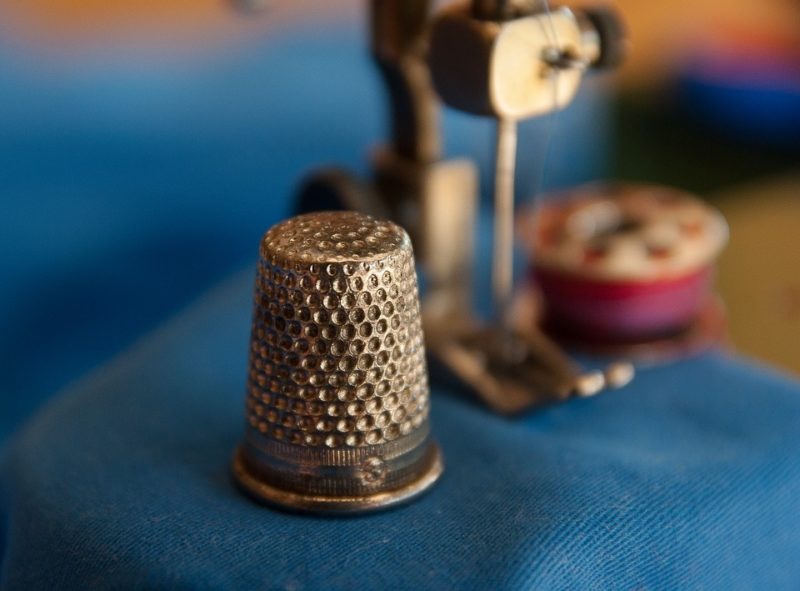You probably know what is a thimble used for in sewing because you put it on your finger to protect it from getting pricked by the needle. However, did you know that this tiny sheath offers other advantages during sewing?
We’ll also talk more about how to wear it properly. But to complete your sewing kit, please take your time to know what do I need to start sewing.

Besides a sewing machine, there is an array of tools that you must have to tackle various sewing projects with ease.
What Is A Thimble Why Is It Used?
A thimble is a small ring or bell-shaped object meant to be used as a finger guard when sewing. It is usually made of metal to protect your fingers from being pricked, and when hand-sewing, the metal thimble can help you safely push the needle into various challenging fabrics.
Besides metal, thimbles can also be made from rubber and leather. This way, you can select the right one for every project.
For example, tailors use the more breathable leather thimble when doing embroidery. With a leather finger guard, your finger won’t sweat too much that it can ruin your work.
Why Would A Tailor Use A Thimble?
For more control in sewing
Beginners can feel awkward having an object on their finger. However, once you get used to the feeling, wearing a thimble can serve as the third finger for sewing.
This solid part of the finger can help you sew more accurately and precisely. You can compare the experience when sewing without a thimble, and you need to pinch the needle between your fingers to insert it into the fabric.
To avoid finger cramps
It can be tiring to the fingers, especially when hand sewing for an extended period. You can prevent the stress on your fingers by employing a thimble to push and control for you.
There are also open-ended thimbles that you can use to manipulate the fabric. This will, of course, make sewing much easier and faster to finish quickly and avoid tiring your hands.
If you expect to sew often, it might be best to invest in a sewing machine instead of doing daily projects by hand. Learn when is the best time to buy a sewing machine to save a couple of bucks.
What Are Thimbles Most Useful For?
According to the Textile Research Centre, thimbles have been used as sewing aids for thousands of years. And its primary use is to aid the tailor with pushing the needle while also protecting getting pricked by it.
Antique enthusiasts also collect old thimbles. Sterling and decorative thimbles are most wanted, and you can sell some really good ones for up to $20.
What are the parts of a thimble?
- Crown/lid
- Side
- Rim/base
- Knurling/indentations
Types of thimbles
- Finger guard thimble: a ring with a long shield that is open on one side
- Thimble ring: a thimble with no crown
- Sewing thimble: open-ended types for manipulating cloth when sewing
- Quilting thimble: usually made of leather with metal on one side for pushing the needle through quilt layers
What Finger Do You Wear A Thimble On?
You will wear your thimble with your dominant hand for sewing on the index or middle finger. This way, you can push the needle onto the fabric, and you won’t get hurt by the needle eye.
How to wear a thimble
- Put the thimble on your middle finger
- Hold the needle between your thumb and index finger
- Use your guarded middle finger to push the eye of the needle when sewing
- Prevent straining your hand by stitching in the direction of where your needle is pointed
- Keep the fabric on the table and stabilized with your other hand
- Never poke in from the top of the fabric and pull out through the bottom, but instead, make and finish a stitch on the same side of the fabric
How Should A Thimble Fit?
The thimble should fit on your finger comfortably, which means it doesn’t feel too constricting or loose. You also want the tip of your finger to touch the top of the thimble, with your nail clearing the guard.
Test the fitting of the thimble by pointing your fingers down and moving them around, or check how it feels when you’re pushing the needle eye. This type of fit for the thimble should be applicable for all types of thimbles.
You will need some time to get used to sewing with something on your finger. If this would be the first time that you’ll wear a thimble, test it for 15 minutes while doing other things throughout the day to get used to the feeling of a finger guard.
How to choose a thimble
- Test a metal, leather, and plastic thimble to find which feels the best when working on your projects
- You can first wear a leather thimble since it’s softer and more breathable
- Consider if you need a thimble with an open end for moving the fabric or a solid tip for pushing the needle eye
- Some thimble are ring-types that would suffice as protection from the needle
Conclusion
And that’s it! We just talked about what is a thimble used for in sewing, which is more than a finger guard.
You can also use it to sew more precisely and prevent finger cramps. Some even collect antique thimbles so that you can sell yours for a reasonable price.
We hope you learned a lot. Leave us a question if you have any.
